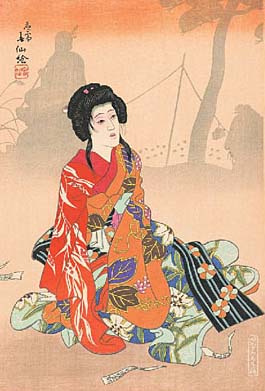| ONATSU KYďRAN |
| Dance title | Onatsu Ky˘ran |
| Authors | Tsubouchi Sh˘y˘ (lyrics) Fujima Kan'emon II (choreography) Tokiwazu Mojidayű VI (music) |
| History |
The dance "Onatsu Ky˘ran" was staged for the first time in September 1914 at the Imperial Theater. The roles of Onatsu and the pack-horse driver were played by Onoe Baik˘ VI and Matsumoto K˘shir˘ VII. |
| Key words |
Ky˘ran Ky˘ranmono Shosagoto Tokiwazu |
| Summary |
The story of "Onatsu Ky˘ran" comes originally from a 17th century novel by Ihara Saikaku. A handsome young man called Seijűr˘ was the son of a sake merchant but was disowned for his wanton lifestyle. Persuaded by friends to take holy orders, he then ran away from the temple, eventually finding work as an apprentice in the house of another merchant, Tajimaya Kuzaemon. There, he fell in love with Kuzaemon's daughter, Onatsu. Eventually the pair eloped, but when a sum of money was discovered to be missing at home, they were pursued and finally caught. After his arrest, Seijűr˘ was put to death, and upon hearing this news, Onatsu lost her mind. Yet, obsessed by the image of her dead lover, Onatsu began wandering through the autumn countryside desperately searching for him. Courtesy of Paul M. Griffith |
| Comments |
The lyrics of the dance were written by one of Japan's most respected literary figures, Tsubouchi Sh˘y˘, and the dance had its first performance in 1914. It is one of the best surviving examples of early 20th century theatre reform, reform that sought to do away with many of the illogicalities of traditional Kabuki dance and to concentrate instead on the "psychological realism" of the characters. The lyrics are far more consistent in content: at no time are we suddenly transported to the Yoshiwara pleasure district in spring, for instance, and there is never any reference to subject matter that has no direct bearing on the story of Onatsu. However, for those of us who love traditional Kabuki dance, this more modern approach is not necessarily any better. By maintaining a consistent story line, the lyrics throw emphasis on narrative and detract from the purely formal aspects of traditional dance. The clear compositional structure which includes the kudoki, the teodori and the chirashi, etc., can be a pleasure to watch in itself, and we enjoy seeing how well the actor performs the set vocabulary of movements and poses for any particular section. Choreography, even when it doesn't seem to make sense, is a vital part of any dance, yet the choreography here seems quite forgettable. In an older work that also depicts madness like "Yasuna" for example, it isn't only the character's psychology we've come to witness but also the actor's skill at mime, at handling the fan and the nagabakama costume, etc., and perhaps above all, we appreciate the changing pace and mood in the composition of the dance as a whole. In contrast, "Onatsu Ky˘ran" is heavy and dark throughout and even the semi-comic antics of a drunken pack-horse driver do little to relieve the sombre mood. It's as though everything else has been sacrificed to the ideal of psychological consistency and the over-riding concern to portray one girl's lunacy. All this is not to say that the lyrics of "Onatsu Ky˘ran" are dull, or that they do no more than tell a simple story. Some sections are extremely poetic and suggestive, and Sh˘y˘ was certainly not above throwing in the odd "makura kotoba" such as "ubatama" for the blackness of the night, etc. It's just that there seems too episodic a progression from one section to the next as one, then another, then yet another character or group of characters turns up along the same road. We don't need all the action to be logically explained in Kabuki dance; that robs it of its charm. Another convention of older dances that has naturally been weeded out of "Onatsu Ky˘ran" is the presence of k˘ken, stage assistants. This means that, whatever lands on the floor, stays on the floor until the bitter end. Unfortunately, this makes for a very displeasing mess on stage as it gradually gets cluttered up with the Buddhist prayer slips that Onatsu throws about and with the autumn leaves that flutter down from above. This visual mess is made all the worse by the repeated appearance of actual children. In the story, a group of village brats make sport of Onatsu by teasing her and goading her into a frenzy, and so their appearance is again entirely logical. But this is a dance, and as a rule, children can't! Although expertly trained, there is still nothing on earth that will give the average child the timing and body control that's necessary for Kabuki dance. They look unsure of their movements and completely lack poise. They sound harsh and too loud and are just basically awful. Courtesy of Paul M. Griffith |
 |
|
Onoe Baik˘ VI portraying Onatsu in a print made by Natori Shunsen in 1935 |
|
|
| Contact | Main | Top | Updates | Actors | Plays | Playwrights | Programs | Links | FAQ | Glossary | Chronology | Illustrations | Prints | Characters | Derivatives | Theaters | Coming soon | News |